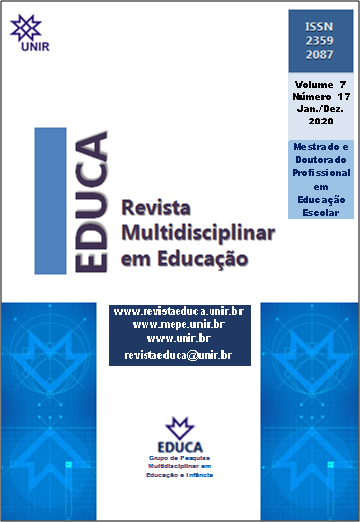Visible learning in steel education in the metallurgical technical course
DOI:
https://doi.org/10.26568/2359-2087.2020.4919Keywords:
Visible Learning. Learning Styles. Mass Balance.Abstract
The use of manipulative materials applied to the principle of mass conservation in the steel balances, by dismembering the molecules of the components of the ore, metals and slag was used in the quantification of learning related to learning styles. In this sense, a mixed research methodology was used, being mostly quantitative: verification of learning styles through the New Learning Styles Index (N-ILS), evidence on mass balance for the calculation of Effect Size, as established by the laboratory in Hattie's Visible Learning. Among the results obtained, the Effect Size calculated for the pedagogical practice stands out, which on average in the three classes was 0.63. Value higher than the 0.40 reference, considered as a satisfactory average intervention and compatible with the Effect Sizes values of similar methodologies. In the qualitative part of the research, semi-structured interviews were conducted where it was possible to understand that the students perceived their own learning. This study innovated when calculating the Effect Size combined with Learning Styles and contributes to the understanding of collaborative learning practices using manipulative material.
References
AUSUBEL, D. P. A aprendizagem significativa: a teoria de David Ausubel. São Paulo: Moraes, 1982.
BIZERRA, A.; URSI, S. Teorias da aprendizagem: influências da psicologia experimental. In: Introdução aos estudos da educação I. São Paulo: USP/Univesp/Edusp; 2014. Disponível em: https://edisciplinas.usp.br/pluginfile.php/1720181/mod_resource/content/1/Teorias%20da%20Aprendizagem%20I.pdf. Acesso em: 04 de maio de 2019.
BORGES, A. Tarciso. Como evoluem os modelos mentais. Ens. Pesqui. Educ. Ciênc., Belo Horizonte, v. 1, n. 1, p. 66-92, jun. 1999. Disponível em: http://www.scielo.br/scielo.php?script=sci_arttext&pid=S1983-21171999000100066&lng=pt&nrm=iso. Acesso em: 04 de maio de 2019.
COLVARA, Laurence Duarte; VIEIRA JUNIOR, Niltom. Os modelos mentais de alunos em relação a vetores em duas e três dimensões: uma análise da dinâmica da aprendizagem e da inadequação das avaliações tradicionais. Ciências e Cognição, Rio de Janeiro, v. 15, n. 2, p. 55-69, ago. 2010. Disponível em: http://pepsic.bvsalud.org/scielo.php?script=sci_arttext&pid=S1806-58212010000200006&lng=pt&nrm=iso. Acesso em: 24 de abril de 2019.
DUQUE, T. O. et al. Falhas nas avaliações tradicionais em diversos níveis de escolaridade: um estudo envolvendo tópicos de matemática financeira através de níveis e subníveis de modelos mentais. Revista Brasileira de Pesquisa em Educação em Ciências. V.15, n.2, p. 427 – 452. 2015.
FELDER, R. M; SOLOMAN, B. A. Learning styles and strategies. 1991. Disponível em: https://www.researchgate.net/publication/257431200_Learning_and_Teaching_Styles_in_Engineering_Education/link/599831d5a6fdcc2615841d21/download. Acesso em: 16 de novembro de 2019.
FERRARI, M. Howard Gardner, o cientista das inteligências múltiplas. Nova Escola. [S.I], 2008. Disponível em: https://novaescola.org.br/conteudo/1462/howard-gardner-o-cientista-das-inteligencias-multiplas. Acesso em: 11 de junho de 2019.
GARDNER, H. Frames of mind: the theory of multiple intelligences. New York: Basic Books, 1983.
HATTIE, J. A. C. Aprendizagem visível para professores. Porto Alegre: Editora Penso, 2017.
HATTIE, J. A. C. Visible Learning: a synthesis of over 800 meta-analyses relating to achievement. London, UK: Routledge, 2009.
MIZUKAMI, M. G. Docência, trajetórias pessoais e desenvolvimento profissional. In: REALI, Aline M; MIZUKAMI, Maria Graça (orgs.). Formação de professores: tendências atuais. São Carlos: Edufscar, 1996.
MOREIRA, M. A. Modelos Mentais. Investigações e Ensino de Ciências.V.1, Nº3, dez. 1996.Também publicado in Encontro sobre Teoria e Pesquisa em Ensino de Ciência – Linguagem, Cultura e Cognição, Reflexões para o ensino de Ciências. (1997), UFMG, Belo Horizonte – Minas Gerais. Disponível em: http://www.if.ufrgs.br/public/ensino/N3/moreira.htm. Acesso em: 26 de abril de 2019.
NORMAN, D. A. Some observations on mental models. In: GENTNER, D.; STEVENS, A. L. Mental models. Hillsdale: Lawrence Erlbaum Associates, 1983.
PIRONEL, M. et al. (orgs.). Perspectivas para resolução de problemas. São Paulo: Editora livraria da física, 2017.
ROGERS, C. Liberdade para aprender. Belo Horizonte: Interlivros, 1972.
RONCA, A. C. C. Teorias de ensino: a contribuição de David Ausubel. Temas em Psicologia. Ribeirão Preto, v. 2, n. 3, p.91-95, dez. 1994. Disponível em: http://pepsic.bvsalud.org/scielo.php?script=sci_arttext&pid=S1413-389X1994000300009. Acesso em: 28 de outubro de 2019.
SKINNER, B. F. The concept of the reflex in the description of behavior. Doctoral dissertation, Harvard University. Cambridge, MA, 1930.
VAN DER SCHEE, J. Algumas considerações sobre como estrutura e feedback podem ajudar crianças a aprender geografia. Giramundo, Rio de Janeiro, v. 1, n. 1, p.7-14, Jan./Jun. 2014. Disponível em: https://www.cp2.g12.br/ojs/index.php/GIRAMUNDO/article/download/3/1. Acesso em: 15 de junho de 2019.
VIEIRA JÚNIOR, N. Construção e validação de um novo índice de estilos de aprendizagem. In: MCTI; UNESCO; CNPq. (org.). Educação para a ciência. Brasília: MCTI, 2014.
VYGOSTSKY, L. S. A Formação Social da Mente. São Paulo: Martins Fontes, 1984.
Downloads
Published
Issue
Section
License
Autores que publicam nesta revista concordam com os seguintes termos:
a) Autores mantém os direitos autorais e concedem à revista o direito de primeira publicação, com o trabalho simultaneamente licenciado sob a Licença Creative Commons Attribution que permite o compartilhamento do trabalho com reconhecimento da autoria e publicação inicial nesta revista.
b) Autores têm autorização para assumir contratos adicionais separadamente, para distribuição não-exclusiva da versão do trabalho publicada nesta revista (ex.: publicar em repositório institucional ou como capítulo de livro), com reconhecimento de autoria e publicação inicial nesta revista.
c) Autores têm permissão e são estimulados a publicar e distribuir seu trabalho online (ex.: em repositórios institucionais ou na sua página pessoal) a qualquer ponto antes ou durante o processo editorial, já que isso pode gerar alterações produtivas, bem como aumentar o impacto e a citação do trabalho publicado (Veja O Efeito do Acesso Livre).



